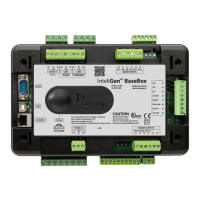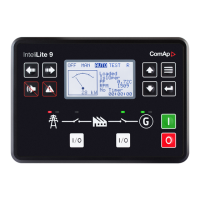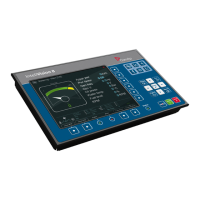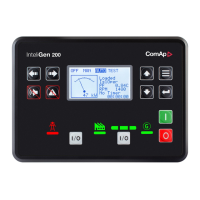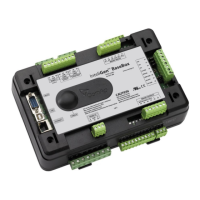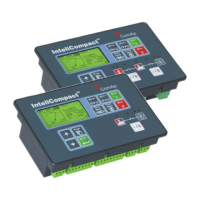2) Set the engine RPM by speed trim on speed governor or by Speed gov bias and
SpeedGovLowLim and SpeedGovHiLim to reach Nominal frequency.
3) To start synchronizing press GCB ON/OFF button. GCB LED starts to flash to indicate
synchronization. To stop synchronization press again GCB ON/OFF .
Slip control adjusting:
4) Adjust Freq gain to unstable speed control and decrease value by 30 % to insure stable
performance.
5) Adjust Freq int to stable (fast and smooth) slip control. Synchroscope movement on the
controller measure screen should slow down and stop (in any position, because Angle
control is off).
Angle control adjusting:
6) Set Angle gain. Synchroscope on the controller measure screen should move slowly
and stop in “up“ position. Set Angle gain to unstable value (synchroscope swings) and
decrease value by 30 % to insure stable performance.
17.1.3. Load control adjustment
Prior to Sync/Load control adjustment, the Volt/PF control has to be adjusted! Load control
loop is active in parallel to mains mode only (MCB feedback closed). Switch off other engines
while adjusting.
1) Set #SysLdCtrl PtM = Baseload, set Baseload value to 30 % of Nominal power of one
gen-set.
2) Set Load gain to the same value as Slip freq gain. Set Load int to zero.
3) Start the gen-set in MAN Mode, press GCB ON/OFF button to synchronize and close
gen-set to mains.
4) When GCB is closed, gen-set load slowly increases to Base load value. Check that gen-
set power is positive (CT polarity!).
5) Increase Load gain to unstable load control and decrease value by 30 % to insure stable
performance. When Load int factor is set to zero gen-set load can differ from required
Baseload.
6) To adjust and optimize Load int change several times Base load between 30 and 70 %
of Nominal power. Usually setting Load int to 100% gives optimal performance.
7) When gen-set is running full load check if
a. Speed governor output voltage value is not limited (not reached SpeedGovLowLim
or SpeedGovHiLim)
b. Speed governor actuator isn’t mechanically limited or operates in small section of
throttle range.
17.1.4. Active and reactive power terminology

